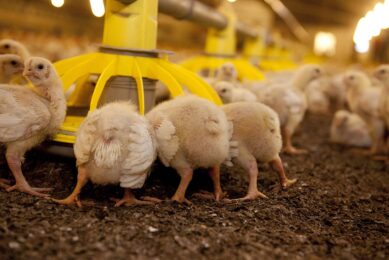The silent element

Sulphur (S) is a widely distributed element in nature playing a key role on diverse biological processes. There is a high amount of scientific interest to better understand the influence of this element on the microbiota, intestinal inflammation and gut health.
In the geosphere, sulphur is the 15th most abundant element. In the biosphere, sulphur is even more abundant since it is incorporated in many organic compounds such as amino acids and proteins and hence essential for life. Chemically, the S atom can be found in all oxidation states between (–II) and (+VI), but only some of them are stable. The common S atom oxidations states are listed in Table 1. Bacteria play an important role conducting the oxidation and reduction reactions leading to these different forms of S.
Sulphur requirements for livestock
Sulphur content in the body is approx. 0.15%. Vertebrates are not capable of producing methionine, thiamine and biotin (vitamins B1 and B8) from inorganic S present in the diet. In monogastrics, these essential nutrients must be supplied and there is no dietary requirement for inorganic sulphur.
Diets for ruminants however should contain 1000 to 3000 ppm of S/ kg DM as ruminal bacteria can metabolise non-protein nitrogen sources as well as elemental, inorganic and organic S for synthetising sulphur amino acids, B1 and B8 vitamins that can be absorbed by the host later. Still, it is important to consider dietary S and drinking water supply for assessing total sulphur intake level.
Sulphur in the gut: Friend or foe?
To avoid toxicity, absorbed sulphur is rapidly oxidised in the liver and kidneys. In case of excess, sulphate present in the blood can create a transitional acidosis affecting the acid-base balance of the body.
According to the NRC (2005), maximum tolerable levels of S in the diet are:
- 3000 ppm for cows and beef;
- 4000 ppm for swine and poultry
- 5000 ppm for horses.
Note: Simple corn and SBM-based diets can usually contain from 100 to 3500 ppm of S.
In the 90s, the University of Guelph (Canada) conducted several trials to assess the response of broiler to inorganic S. In relation to increasing S content, a linear depression in weight gain was reported as a consequence of reduced feed intake and to impaired anion-cation balance (Figure 1).
Figure 1 – Relative weight gain (% to control treatment) of broilers fed S-supplemented SBM diets.

In poultry, S toxicity was also shown to affect bone ash formation as well as ovary function in layers and breeders.
In pigs, a good tolerance to dietary S has been reported by the University of Illinois where growth performance or carcass traits were not affected by up to 4000 ppm of S in corn-SBM/ DDGS diets. However, the USDA has found that a dietary excess of S (8200 and 12,100 ppm for piglets and 6400 ppm for gilts) has led to reduced ADG.
In addition, graded amounts of S resulted for gilts in an increase in manure acidity, N and S content and odour related compounds like H2S. Toxic effects of inorganic S salts (e.g. SO42-) in monogastric species are usually related to abnormalities in water balance in the GIT generally manifested as diarrhoea resulting from the osmotic attraction of water into the gut lumen.
Additionally, under anaerobic conditions (e.g: in the manure pit or in the litter), excretion of S is rapidly converted into H2S by sulphate reducing bacteria. The presence of such gas in the barns affects the respiratory tract and animal welfare as H2S is extremely toxic.
In ruminant, for a long time, Polioencephalomalacia (PEM) was associated with thiamine deficiency. Nowadays, PEM condition is known to be related to an excessive ruminal H2S production when S is ingested in excess. The gas is absorbed across the ruminal wall and interferes with cellular energy production at mitochondrial level. Since the brain has a high energy requirement, it is one of the most affected organs. The neurotoxic effects of H2S can be also mediated via eructation, with other gases, from the rumen and absorption through the lungs.
Negative impact on intestinal butyrate use
Recently, a relationship between sulphur and various colonic diseases in humans has been identified. Strong evidence showed that high animal protein diets (containing meat, eggs) increase abundance of sulphate reducing bacteria and H2S production, while inhibiting butyrate producing species (e.g. Ruminococcus).
In healthy colonocytes, low extracellular concentrations of H2S can be oxidised by mitochondria for detoxification. But at excessive concentrations, H2S inhibits the cytochrome C oxidase activity impacting the mitochondrial respiratory chain and, therefore, oxygen utilisation by the colonocytes.
It is also known that H2S is limiting butyrate oxidation (responsible for about 70% of the energy for the colonocytes). This energy deficiency is often associated with the prevalence of ulcerative colitis and impaired gut permeability.
Sulphur in the radar for the future?
Since the feed industry started to move to the so-called “antibiotic-free” nutrition, gut health has become a key pillar for maintaining profitability for all livestock production. Thus, increasing attention has been focusing on the role of microbiota and its interaction with gut epithelial cells and on incidence of inflammatory gut disorders.
In this respect, there is a need to better understand the potential effects of S on host metabolism and on shaping microbiota along the gastrointestinal tract of both monogastric and ruminant species.
The right dietary allowance of inorganic and organic S-compounds as well as the consideration of the oxidation and speciation states of S can help in maintaining the structure of the gut ecosystem and epithelial barrier function.
Authors:
Dirk Schaumlöffel, Research Director at CNRS/University of Pau, France and
Arturo Piñón R&D Director, Animine France
Join 31,000+ subscribers
Subscribe to our newsletter to stay updated about all the need-to-know content in the poultry sector, three times a week. Beheer
Beheer





 WP Admin
WP Admin  Bewerk bericht
Bewerk bericht